
10 Facts about Radial Loop Fingerprints!

JULY 15, 2013
10 Facts about Radial Loops!
In the perspective of fingerprints, the term 'radial' (loop) refers to the radius - a bone in the forearm that joins the hand on the same side as the thumb. Radial loop fingerprints are characterized by a flow of the pattern that opens in the direction of the radius (or thumb side of the hand) featured with a triradius located at the ulna (pinky) side of the hand. Radial loops are not very common: in general they are less common than ulnar loops, whorls and arches; radial loops are most likely found on the index finger. Probably interestingly, this article presents various clues (in terms of: the volar pads + a complex of genetic populations differences) which indicate that the radial loop represents a fundamentally different pattern compared to the ulnar loop!
In the fields of hand reading radial loops tend to get associated with 'people who do not go with the flow' - refering to the fact that the radial loop represents sort of the opposite of the much more common ulnar loops.
Until 2019 there is no confirmed evidence available that substantiates this assumed 'belief'.
What are the facts?
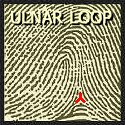
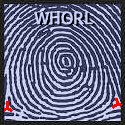
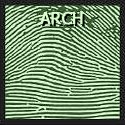
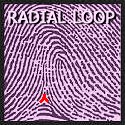
ULNAR LOOP [UL] - WHORL [W] - ARCH [A] - RADIAL LOOP [RL]
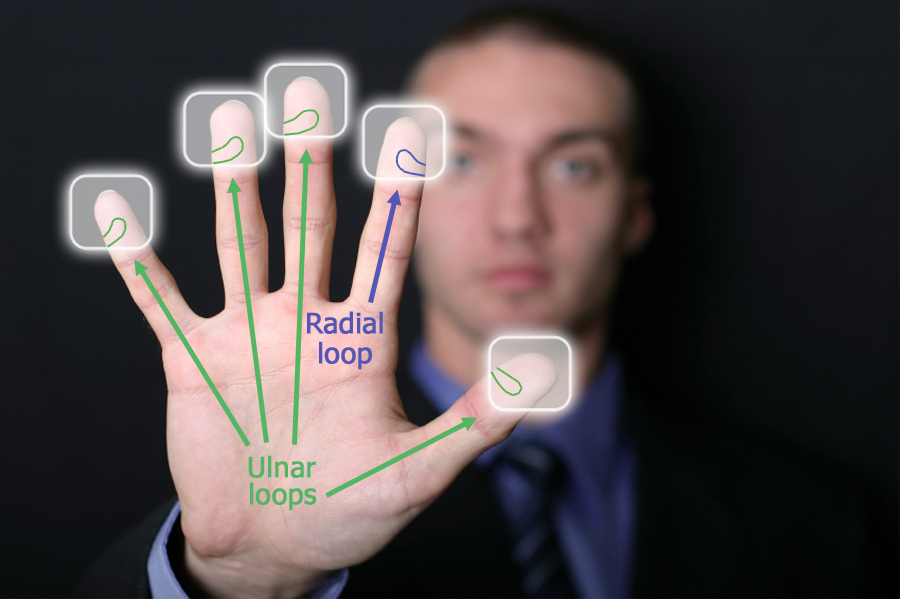
• RADIAL LOOPS FACT 1: Least common of the 4 major categories
In most regions around the world represents the radial loop (international avg.: 3.0%) the least common pattern of the 4 major fingerprint categories - after in respective: the ulnar loop (50.0%), the whorl (41.0%), and the arch (6.0%) - percentages taken from the article: The Fingerprints World Map (in nearly all international populations the radial loop percentage is less than 10% of the ulnar loop percentage!).
In nearly all regions around the world is the radial loop by far most commonly found on the index finger (usually more than 80% of all radial loops are found on the index finger); only a small minority of all radial loops are found on the other 4 fingers (usually less than 20%). Especially in Western/North-European populations the single-hand combination (thumb to pinky)
UL-RL-UL-UL-UL typically represents the 2nd most common combination (after the UL-UL-UL-UL-UL combination).
The 6 most common fingerprints combinations with at least one radial loop on any finger (6 out of 6 include a radial loop on the index finger) are listed according estimated order of prevalence below:
I - II - III - IV - V (= thumb to pinky finger)
UL-RL-UL-UL-UL
W-RL-UL-UL-UL
W-RL-UL-W-UL
UL-RL-UL-W-UL
UL-RL-A-UL-UL
UL-RL-RL-UL-UL
NOTICE: A = arch, UL = ulnar loop, RL = radial loop, W = whorl.
Indicative percentages (derived from 30 international populations around the world) for the presence of radial loops on the individual fingers in the general population are: 1.3% for the thumb, 11.35% for the index finger, 1.4% for the middle finger, 0.7% for the ring finger, and 0.5% for the pinky fingers.
The picture below provides an overview of the distribution for the 4 major fingerprint types among male- and female populations from in respective: the US, UK, China, Iran & Nigeria.
NOTICE: In primates the distribution of radial loops is very different compared to man; Cummins & Mildo (1943) report:
"Radial loops in chimpanzee fingers are almost confined to digit I [thumb], contrasting with the characteristic concentration of these patterns on digit II [index finger] in man".
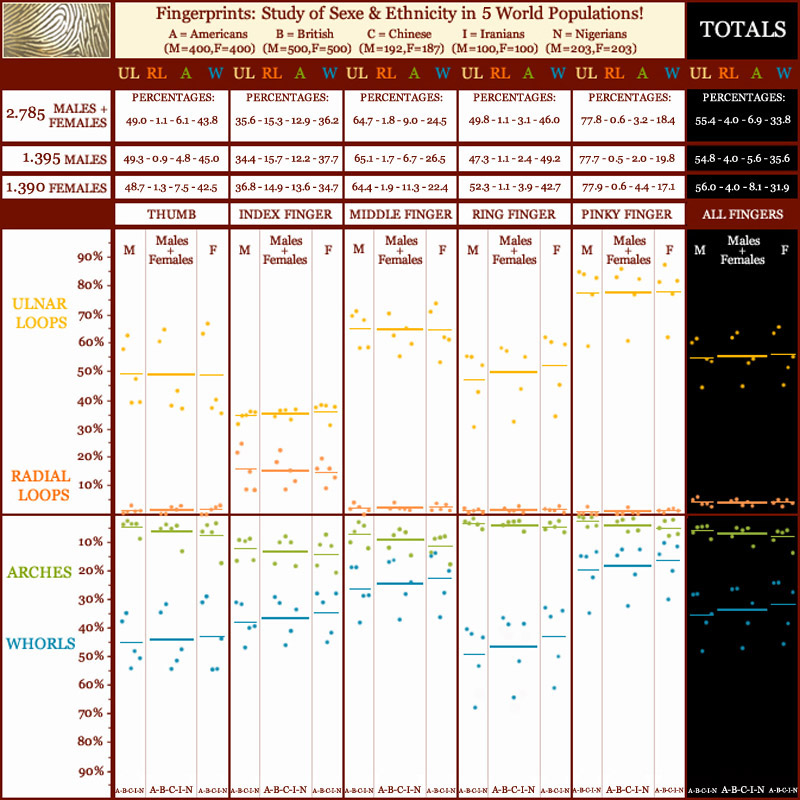
Fingerprint pattern configurations correlate with the location-, shape- and size of the so-called prenatal volar pads (= swelling of mesenchymal tissue in the 3rd month of pregnancy). And skin ridges are understood to become manifest in the surface of the skin due to tension & pressure forces in upper layer of the skin.
Volar pads typically tend to manifest as intermediate pads with a location slightly shifted towards the radial (thumb) side of the hand - which represent the typical features that get associated with the most common major category: ulnar loops. However, sometimes the location of the volar pad is shifted towards the ulnar side of the hand - which results in a radial loop.
The major principles describing the correlation between early prenatal volar pad development & fingerprint pattern configurations is described in the picture below (according Babler, 1987); higher symmetric pads tend to develop into whorls, and lower symmetric pads tend develop into arch fingerprints.
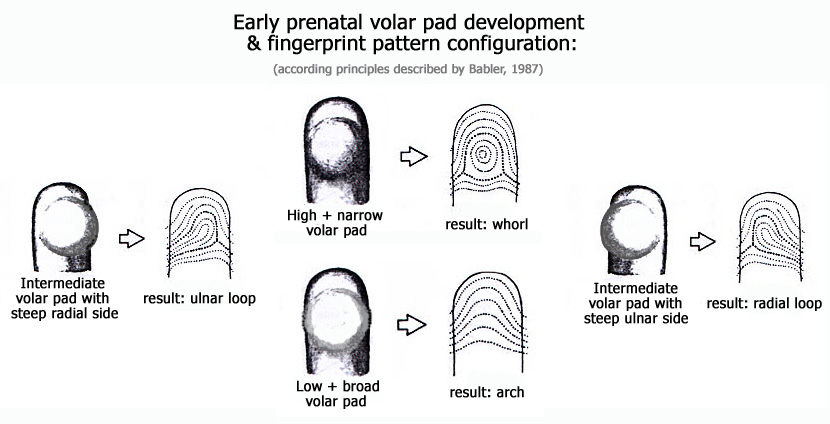
Fingerprint statistics around the world point out that the prevalence of radial loops varies from country to country. Radial loops are clearly most common in Europe (especially in north-west European countries) and in the south of the African continent; radial loops are clearly less common in south-east Asia (especially in the pacific islands) + the indigenous Australian islands.
Combining the statistics in the map below + the data featured inside the fingerprint world map, the result shows that there is particularly one region in the world where the highest percentages of radial loops are usually found: north-west Europa (in the next paragraph more details specified for males and females are presented inside the table).
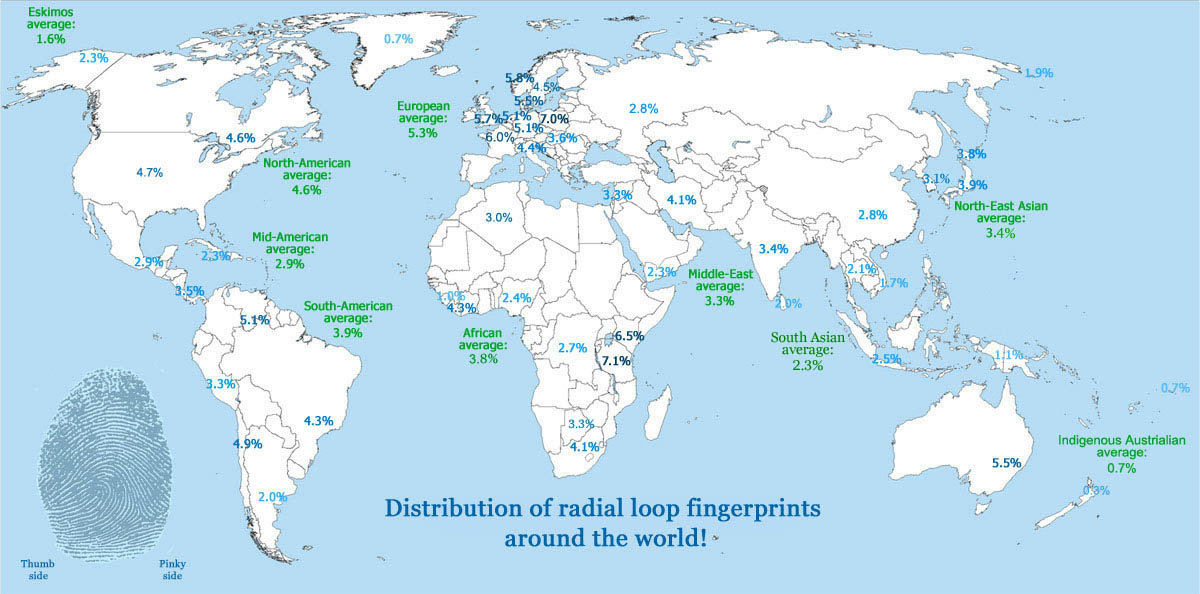
 Fingerprint statistics around the world point out that the prevalence of radial loops also varies between the sexes; these are the typical patterns (see for example: Cummins & Midlo in 'Finger prints, Palms & Soles'; 1943, p.273):
Fingerprint statistics around the world point out that the prevalence of radial loops also varies between the sexes; these are the typical patterns (see for example: Cummins & Midlo in 'Finger prints, Palms & Soles'; 1943, p.273):
- Arches are typically more common in females.
- Ulnar loops are typically more common in females.
- Whorls are typically more common in males.
Just like whorls, radial loops also typically have a higher prevalence in males (confirmed in 9 out of 10 populations displayed below); however it is important to be aware that this pattern is likely only to manifest clearly when at least one of the other three patterns (listed above) is present.
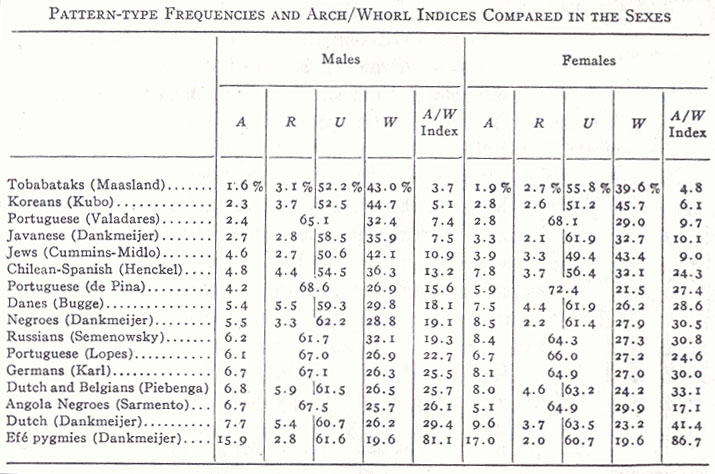
In the general population radial loops typically show a uniform distribution featured with a sharp peak on the index finger. However, in genetic disorders the distribution is often very different.
For example, in Down syndrome (trisomy 21) the distribution of arches is relatively low and it is irregular with 2 relatively small peaks: one peak represents a high percentage of radial loops at the ring finger + pinky, and one small peak that represents a relatively small percentage of radial loops at the index finger - see picture below.
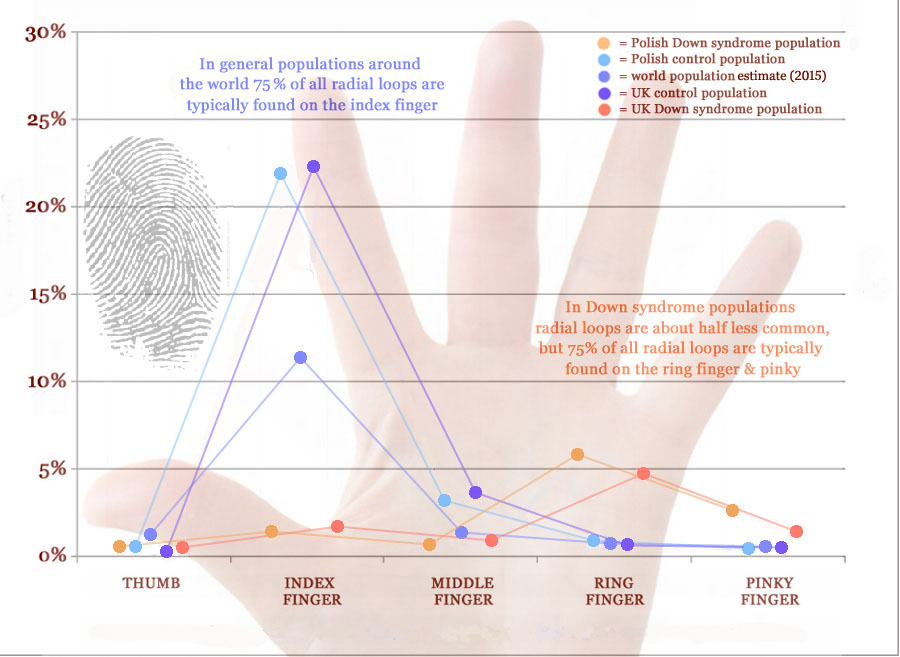
Studies beyond Down syndrome have as well indicated that many other inborn chromosomal disorders also tend to display a different distribution of radial loops across the five fingers; the sharp peak at the finger is missing in all of the following syndromes:
- Trisomy 18 (Edward syndrome): radial loops are more common on other fingers than the index finger (esp. on the thumb);
- Trisomy 13 (Patau syndrome): radial loops are more common on other fingers than the index finger (esp. on the ring finger);
- Fragile-X syndrome (Martin-Bell syndrome): radial loops are relatively common on the thumb, index, and middle finger;
- De Lange syndrome: radial loops are more common on other fingers than the index finger (esp. on the middle finger);
- Rubinstein-Taybi syndrome: radial loops are more common on other fingers than the index finger (esp. on the middle finger);
- Williams-Beuren syndrome: radial loops are more common on other fingers than the index finger (especially on the middle- and/or ring finger).
NOTICE: Various studies have reported results which suggest that a radial loop on the index finger could represent a small clue towards high intelligence (more details see: Iran, 2009; US, 1967).
An excess of radial loops has been associated with some specific types of congenital heart disease, however results have not been confirmed in some other studies (NOTICE: There are quite a few reports where Atrial Septal defects have been associated with radial loops in rare genetic reports).
In general radial loops have so far only in relatively rare cases been associated with some non-genetic diseases; one of the few examples is the rubella virus. Also, abnormal distributions of radial loops has been reported for Alzheimer disease (where radial loops on the fourth and fifth digits were more prevalent in patients with senile dementia of the Alzheimer type [SDAT]).
In a Dutch population radial loop fingerprints turn out to be (slightly) more common among extraverts (= high scorers on the Big Five dimension Extraversion) than among introverts (= low scorers on the Big Five dimension Extraversion) - see picture below. The distribution of radial loops in introverts appears shifted towards the ulnar fingers, while in extraverts the radial loops appear shifted towards the index finger.
Radial loops on the ring finger or pinky are only present in 2 out of the 44 introverts (4.5%) - both individuals do not have a radial loop on the other fingers. Among the 68 extraverts radial loops are only present on the index finger and in one person on the middle finger (this person also has radial loop on both index fingers).
Radial loops on both index fingers are in the studied population more than 2 times more common in the extraverts (11.1%) than the introverts (4.5%). More details are presented inside the article: Phantom Pictures for the Hand in Extraverts & Introverts.
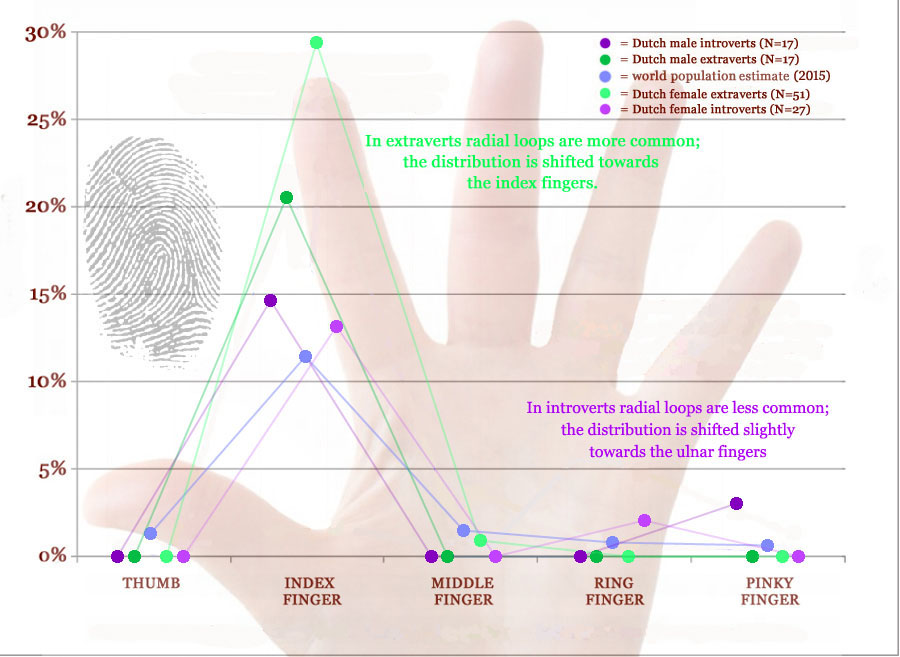
- Radial loops & the Big Five factor Neuroticism -
In a Dutch population radial loop fingerprints turn out to be clearly more common in high scorers on the Big Five dimension Neuroticism, where the 5-fingers average (4.41%) is almost 65% higher than in low scorers (2,68%) - see picture below.
Radial loops on the middle-, ring- or pinky finger are only present in 2 out of the 34 Neuroticism high scorers (5,9%) - both individuals do not have a radial loop on the other fingers; none of the Neuroticism low scores have a radial loop on these fingers.
Interestingly, a likewise tendency has been noticed regarding a higher prevalence of 'radial whorls': the 5-fingers average for 'radial whorls' in Neuroticism high scorers (7.35%) is almost 59% higher than in Neuroticism low scorers (4,63%).
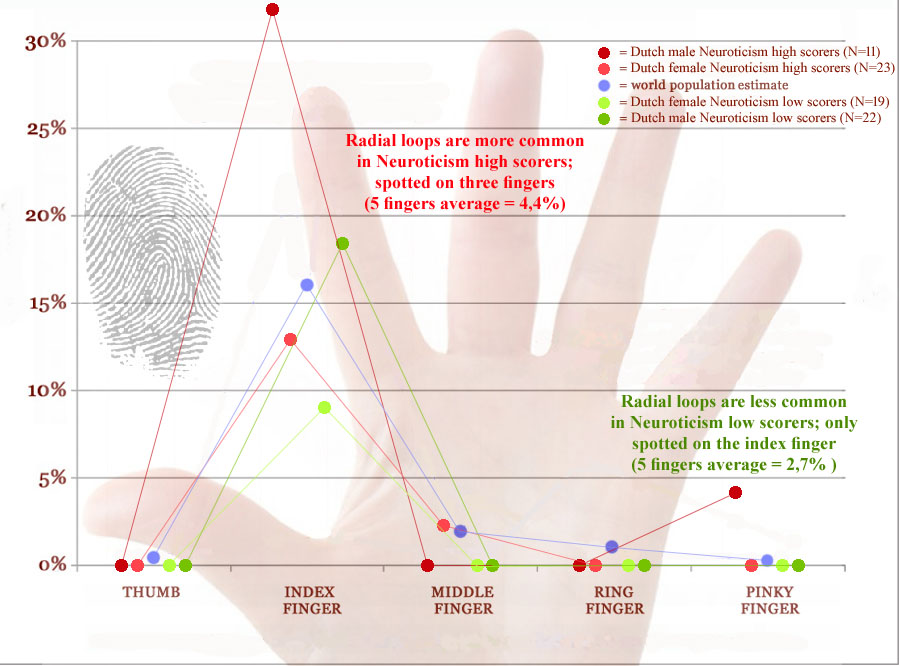
Distribution charts for the radial loop will later become avaiable here for high- and low scorers on the other Big Five factors: Openess (originality), Altruism (accommodation) & Conscientiousness (consolidation).
NOTICE: An analysis for the Big Five dimension Altruisim has indicated that for males and females together the distribution of radial loops across the five fingers does not vary from the normal distribution in high- or low scorers on Altruism.
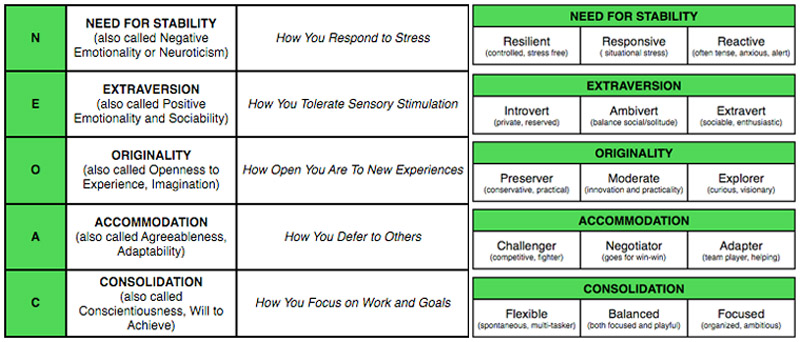
Beyond the fact that both the radial loop and the arch are most commonly found in the index finger, also data from international studies in general populations (a) & genetic disorders (b) present clear evidence for a strong connection between radial loops and arches (+ a weaker connection between radial loops and whorls):
• a - Native populations in Oceania are known to exhibit a very high number of whorls (typically above 60%), a very low number of arches (typically below 1%), a very low number of radial loops (typically below 1%), and an extremely low 'radial-ulnar loop ratio' (typically below 3%). Also, native populations (pygmies & bushmen) in the southern tip of Africa are known to exhibit a very high number of arches (typically above 12%), a very low number of whorls (typically below 30%), a considerable number of radial loops (between 1.4% and 4.2%), and considerable 'radial-ulnar loop ratios' (between 2.5% and 9%). This suggests that in international populations high numbers of whorls are typically featured with less radial loops, and high numbers of arches are typically featured with more radial loops than usual. Source: Babler, 1977.
• b - Most trisomy populations and quite a few genetic disorder populations are known to exhibit a very high numbers of arches (trisomy 18: 88.1%, trisomy 13: 22.7%, trisomy 8: 45.6%), very low numbers of whorls (trisomy 18: 0.5%, trisomy 13: 17.3%, trisomy 8: 14.4%), a considerable number of radial loops (trisomy 18: 3.3%, trisomy 13: 14.2%, trisomy 8: 3.3%), and very high 'radial-ulnar loop ratios' (trisomy 18: 60.0%, trisomy 13: 37.3%, trisomy 8: 12.4%). Also, in Cornelia de Lange syndrome, Rubinstein-Taybi syndrome & fragile-x syndrome, are known to exhibit very high numbers of radial loops and arches. And there appear no syndromes which are known to exhibit a high number of radial loops combined with a high number of whorls. This strongly suggests that in chromosomal disorders high numbers of arches are typically featured with more radial loops than usual. Sources: Schaumann & Alter, 1976 & fragile-x syndrome & the hand.
NOTICE: Down syndrome (the most common trisomy syndrome) is know to exhibit high numbers of ulnar loops only and arches, radial loops and whorls are usually all lower compared to normal populatons - therefore there is no apparently relationship visible in Down syndrome regarding how radial loops relate to arches and whorls.
So, even though the prevalence of radial loops in individuals may suggest that radial loops are more often featured with whorls than with arches, this is just an apparent spurious relationship resulting from the fact that both the radial loop and the arch are most commonly found on the index finger - see above: radial loop fact 2. Because next to the distribution of radial loops in the five fingers, also the distribution in both international populations and genetic disorders clearly suggest that radial loops are fundamentally more linked to arches than to whorls!!!
Finally, the presented evidence goes beyond the indisputable relationship between ulnar loop and radial loops - which is much stronger than the connection between radial loops and arches; in this latter perspective one can also fundamentally understand the relatively weak correlation between radial loops and whorls as a sensible and obviously logical connection resulting from the indisputable strong negative correlation between ulnar loops and whorls!
An overview of well-known people who have arch fingerprints (assessed according the FBI system):
•
Right hand [thumb to pinky]: whorl - radial loop - ulnar loop - ulnar loop - ulnar loop
Left hand [thumb to pinky]: ulnar loop - ulnar loop - ulnar loop - ulnar loop - ulnar loop
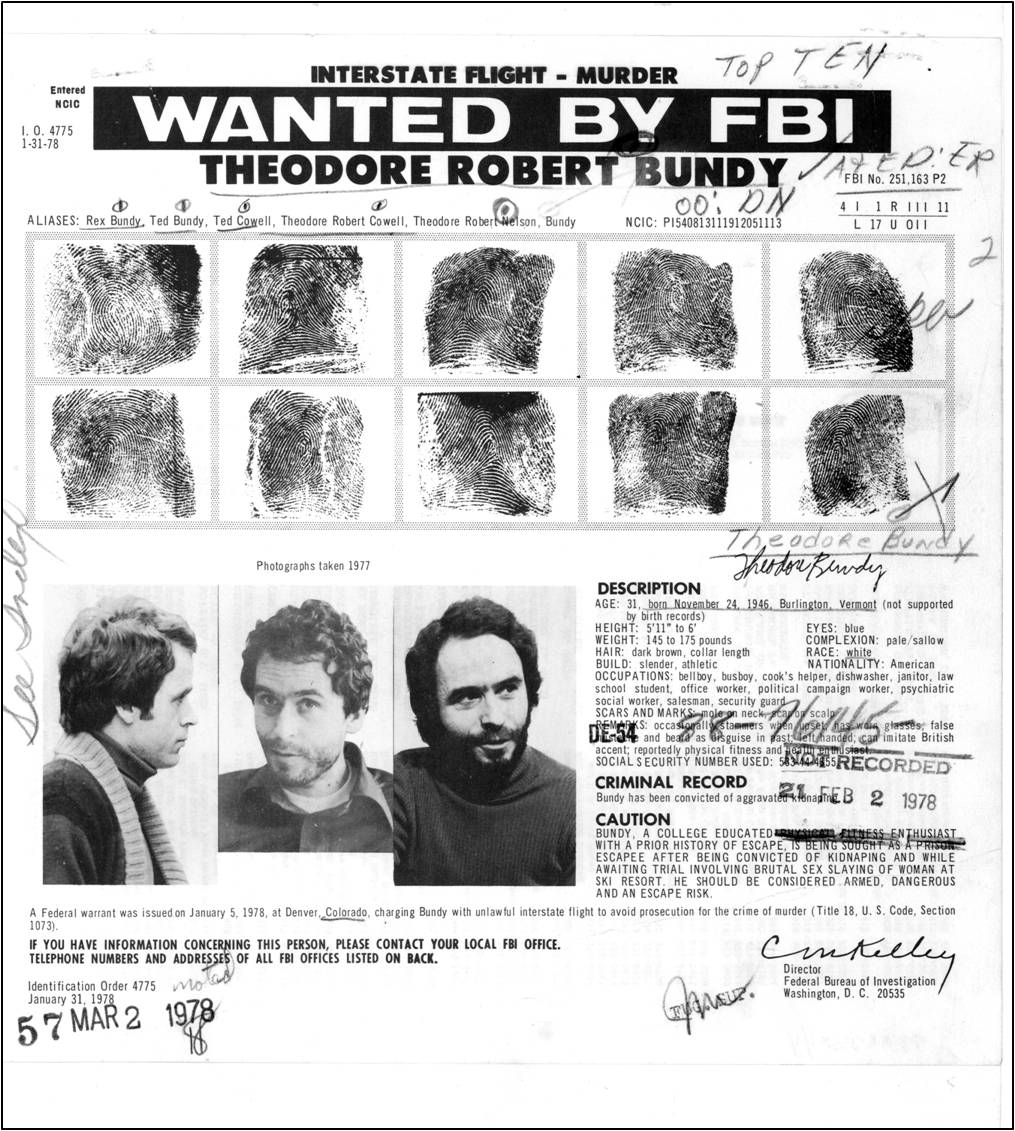
•
Right hand [thumb to pinky]: ulnar loop - (ulnar) central pocket loop - ulnar loop - ulnar loop - ulnar loop
Left hand [thumb to pinky]: ulnar loop - radial loop - ulnar loop - ulnar loop - ulnar loop
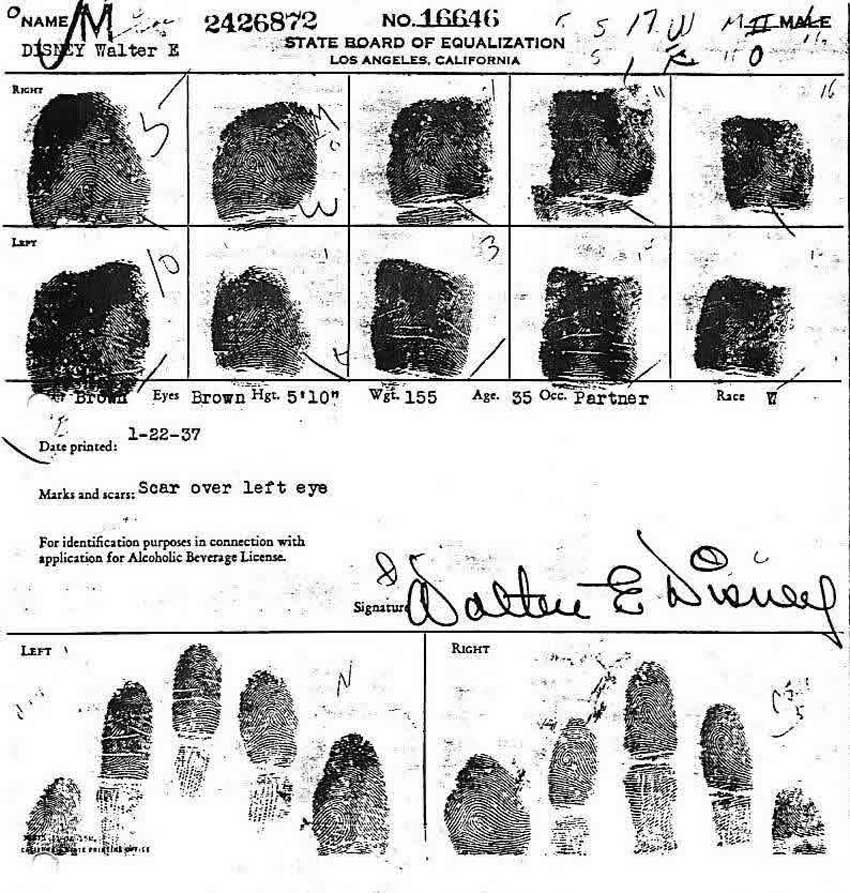
•
Right hand [thumb to pinky]: whorl - radial loop - ulnar loop - whorl - ulnar loop
Left hand [thumb to pinky]: ulnar loop - whorl - ulnar loop - ulnar loop - ulnar loop

•
Right hand [thumb to pinky]: ulnar loop - radial loop - whorl - whorl - ulnar loop
Left hand [thumb to pinky]: ulnar loop - whorl - whorl - whorl - ulnar loop

•
Right hand [thumb to pinky]: ulnar loop - radial loop - whorl - whorl - ulnar loop
Left hand [thumb to pinky]: ulnar loop - radial loop - whorl - whorl - ulnar loop

•
Right hand [thumb to pinky]: radial loop - arch - tented arch - (ulnar) central pocket loop - ulnar loop
Left hand [thumb to pinky]: arch - (radial) double loop - ulnar loop - ulnar loop - ulnar loop

For statistical purposes - the following famous persons do NOT have radial loops:
Clyde Barrow (American outlaw & robber - Bonnie & Clyde)
Al Capone (American gangster)
Adolf Eichman (Nazi)
Albert Einstein (theoretical physicist)
Ernesto Che Guevara (guerrilla leader)
Ernest Miller Hemingway (American author & journalist)
Martin Luther King (Baptist minister, civil rights and anti-war activist)
Richard Nixon (US president)
Lee Harvey Oswald (assumed sniper who killed former US president John F. Kennedy)
Elvis Presley (singer)
James Earl Ray (convicted of the assassination of civil rights and anti-war activist Martin Luther King, Jr.)
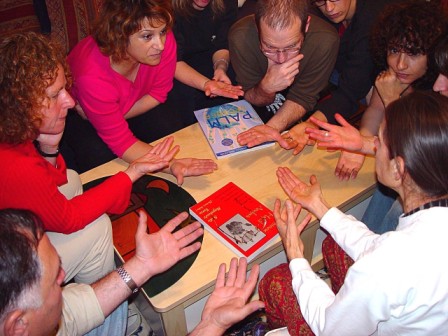
Some of the hand reading experts in the Global Hand Reader Network have presented interesting contributions on the 'radial loop' inside their book(s):

Hand Analyst Ed Campbell writes in his book 'Encyclopedia of Palmistry' (page 114):
"Radial loops are generally found on the jupiter finger and indicate an inward flow of energy, a nurturing or mothering quality. They can also be found on the thumbs, indicating an inward flow of willpower, but they are seldom seen on other fingers."

Palmist Johnny Fincham writes in 'Palmistry: From Apprentice to Pro in Twenty-Four Hours' (page 65+66):
"Radial loop - Whenever you find a radial loop on a digit this is remarkable and will affect the person's consciousness strongly.
The radial loop indicates such an extreme mental state of openness to others that they lose sight of their own desires. Radial loops create a compulsion to prioritize others needs over one's own, and an insecure, unstable, hyper-responsive personality."

Chirologist Jennifer Hirsch writes in 'God Given Glyphs' (page 126):
"It is the radial loop owners' keen hyper responsiveness that make them different from people with ulnar loops. Those with ulnar loops are more tribe oriented 'followers', whereas people with radial loops have more versality and ingenuity.
Radial loop bearers have a strong emotional need to appear to co-operate, while their vision and imagination could well put them in leadership positions."
April 2014 update:

Hand analyst Magda van Dijk writes in 'Standaardwerk Univerele Handleeskunde' (page 165):
TRANSLATED FROM DUTCH LANGUAGE: "A radial loop belongs to a person who has his own ideas and his own way of working, especially if he wants to start something new.
He's open to suggestions from others, but only if these correspond with his own interests or ideas.
He likes to take initiative, and tends to do this by putting his own interests above those of others."
![]() FINGERPRINTS INDEX:
FINGERPRINTS INDEX:
INTRO: Fingerprints & Hand Diagnostics
• HISTORY of Fingerprints
• CLASSIFICATION of Fingerprints
• SEXE DIFFERENCES & Fingerprints
• ETHNIC DIFFERENCES & Fingerprints
• DISEASES & Fingerprints
• Fingerprints & BEHAVIOR!
• FINGERPRINT DISTRIBUTIONS on the 5 Fingers
• WORLD MAP of Fingerprints
• 10 Facts about radial loop fingerprints
• 10 Facts about arch fingerprints
• MORE NEWS about Fingerprints
• Dermatoglyphics Multiple Intelligence Test